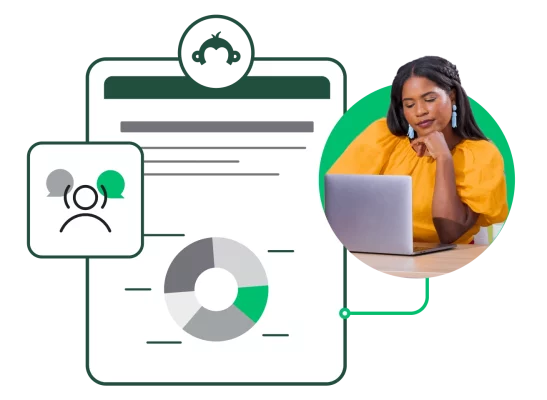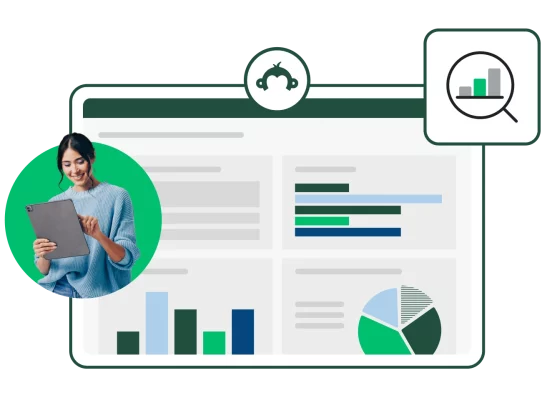Market research surveys: the quickstart guide
Create powerful market research surveys quickly and easily with SurveyMonkey. Discover how to craft surveys to make market research easier.

Market research surveys are intuitive and easy-to-use tools to gather information from your target markets. Whether you’re a Fortune 500 company or a small startup, you can use market research surveys to better understand your target audience.
You can use these surveys to access key demographic information, finding out just about anything—from what customers like about your business to what kind of products your market needs.
To position yourself to keep existing customers or gain new business, you’ll need the right data to back you up. Let’s discover how to create and conduct market research surveys to get the information you need.
What is a market research survey?
A market research survey is a research method used to gather insights, information, and data from your target audience. Sending out a tailored survey allows you to collect extensive feedback on a large scale. With ample responses, you can turn survey results into actionable steps to improve your business.
Here’s a glimpse of some of the information you can gather with market research surveys:
- Demographic information: Data on your customers’ gender identification, income level, age, highest level of education, location, and more.
- Purchasing habits: You can survey people’s buying habits, questioning how often they shop with your business.
- Opinions: You can use market research surveys to ask your audience what they think about your products and services.
- Desires: Survey your audience to gather insight on what they would like to see your business provide in the future or what the market lacks.
- Intentions: Discover whether customers would be more or less likely to shop with your brand if you provided certain services.
As a form of data collection that’s quick to deploy and easy to scale, market research surveys are by far one of the best methods to gather insight from your customers.
Related reading: Why are surveys important in research?
Market research vs. marketing research
While market research and marketing research may sound similar, they provide different information.
Market research gathers data that can help a business better serve its customers. Market research is vital when businesses want to enhance their offerings and improve their products.
On the other hand, marketing research identifies data that can support your marketing team’s efforts. Marketing research revolves around the four P’s of marketing: product, pricing, place, or promotion. Here’s what each of these segments of marketing research hopes to discover:
- Product: What aspects or features of the product or service are most valuable for a customer?
- Pricing: Is the current price too high, too low, or just right for customers?
- Place: Is the product widely available through the purchase pathways that customers want to interact with?
- Promotion: What forms of advertising and the delivery channel are best for the customer?
Simply put, marketing research is any data that informs the customer’s purchase decision. Marketing teams can use this data to enhance packaging, optimize pricing strategies, and deliver effective advertising to the customer.
Market research is a much broader form of customer data capture that spans all customer touchpoints and focuses on the customer experience (CX) with your brand as good as it can be.
Before you begin your market research survey, it’s a good idea to become familiar with the two main types of market research: Primary market research and secondary market research.
| Definition | Methods | Real-world example | |
| Primary market research | Primary market research is the act of gathering data that you haven’t already collected. | Conducting online surveysRunning a focus groupHosting 1-1 customer interviews.Interviewing industry experts or SMEs | A business creates a survey about purchase habits and then shares it with its customers. |
| Secondary market research | Secondary market research is the act of gathering data that someone has already produced. | Pre-existing company dataPre-existing market dataPublic records.Government reportsPublic industry reportsConsumer market trend data | A business accesses an existing study to gather data on an industry trend that interests them. |
Want to learn more? Read our complete guide on the difference between primary and secondary research.
Types of market research survey
When launching market research surveys, you should have a clear intent in mind. The more specific your survey is, the more precise the data you gather will be.
Before diving into specific survey types, you may want to understand the fundamental approaches to survey research. Learn about the three main types of survey research — exploratory, descriptive, and causal — to help you choose the right framework for your market research goals.
Now, let’s explore some of the most common types of market research surveys.
Competitor research survey
A competitor research survey allows a business to discover who its competitors are and how its customers perceive them.
Typical questions on a competitor research survey include purchase frequency questions and open-ended “when you think of this product category, what brands come to mind?”
You can use a competitor research survey template to rapidly measure your competitor ecosystem.
Consumer behavior survey
A consumer behavior survey aims to understand where each customer is on their customer journey. By surveying how they feel about your brand against their purchasing stage, you can gather more information to help move them along their journey.
Typical questions in a consumer behavior survey are:
- Are you the primary decision maker in your household regarding purchasing this product category?
- How do you typically find out about brands in this product category?
- Which of the following brands are you aware of?
A consumer behavior survey template will allow you to monitor how your customer sentiment changes over time.
Brand personality survey
The public image of your brand can rapidly change, with customers developing opinions based on your public actions and advertising techniques. A brand personality survey monitors how your customers perceive your brand.
Here are some typical questions on a brand personality survey:
- When was the last time you used this product category?
- What words first come to mind when you think of our brand?
- How unique is our brand?
Get started with a brand personality survey template to understand your brand associations and how they change over time.
Typical customer demographics survey
A typical customer demographics survey will gather information on all relevant demographic features of your clients' customers. By getting to know who makes up your clients’ audiences, you can better help them succeed.
Common questions on a customer demographics survey are:
- How old is your target customer?
- What gender does your target customer typically identify as?
- What is the highest level of school your target customer has completed?
Get started with a typical customer demographics survey template to better help your clients succeed.
Price testing survey
Price is one of the central factors that influence buying decisions. A price testing survey will help evaluate whether or not your customers are happy with the amount they pay for your products and services.
Here are three routine questions on a price testing survey:
- How often do you purchase this product category?
- How much do you typically pay for this product category?
- How satisfied are you with the amount of money you typically pay for this product category?
Use the SurveyMonkey price testing template to rapidly poll your audience and get the insights you need to optimize your pricing strategy.
13 ways market research surveys can grow your business

Take action on your market research survey knowledge. Here are a few of the most popular ways businesses use market research surveys and how to get the best data out of them.
1. Reach a specific audience
Surveys are a great opportunity to get input from your target market. With market research survey results from your target market, you can make customer-centered, data-driven campaigns and solutions that exceed customer needs and drive business profitability.
If you have trouble finding your target market, you can reach them through our panel of respondents on SurveyMonkey Audience.
2. Research and analyze a target market
A market research survey can help you understand several aspects of your target market, allowing you to improve the quality of your decisions. This includes anything from understanding the potential market size to determining the optimal price for your products.
Before you earmark funds for any marketing plans or initiatives, you need to be confident that the strategies you’re considering will drive your success.
3. Measure brand awareness
Your company or product might mean the world to you, but it’s hard to know what your target market thinks of it. A brand awareness survey can help you understand what your customers and prospects think about your company, image, and products.
Ask respondents how they feel about you compared to your competitors and why they are interested in your products and services.
4. Gain insights on your product, or a future product
Sending an online product feedback survey to your target audience will help you gain insights that drive product improvements, innovations, and ultimately lead to efforts that boost sales.
To get product feedback, you’ll ask questions like: “What changes would most improve our new product?” Or, “What do you like most about competing products currently available from other companies?”
Related reading: New Product Research Template
5. Analyze competitors
Want to know who you should keep an eye on in the market? The best way to get an answer is by asking your target audience. You’ll get an inside look at their buying process and how they think about products that are similar to yours.
Related reading: What is data analysis, and why is it important in market research?
6. Research and analyze a target market
With the increasing importance of social media in your marketing mix, online social media surveys are a great way to figure out which social media channels you need to pay attention to.
Surveys help you understand the “why” and give you ideas for how to serve your market better on each channel.
7. Dive deeper into customer demographics
Need to identify potential customer demographics in a new service area? Ask potential customers about their gender, age, location, income, where they shop, what they do for fun, how many children they have, and more.
Demographic information is essential to helping you understand your target market, which, in turn, improves your messaging and campaigns.
8. Conduct market segmentation
Segmenting your target market by honing in on smaller groups that share common attributes (such as demographics, geography, lifestyle, product usage, brand affinity, etc) might help support decision-making processes and tip the scale in your favor.
When you do market research, it’s easier to identify different segments and know what they want.
9. Decide which creative assets to use in your next campaign
Would your target audience be more likely to respond to an online banner ad or a billboard on the highway close to their homes? Market research surveys can help you put these questions to the test and get feedback that points you in the right direction.
Over the long run, you’ll be in a position to better prioritize your ad spend and resources.
10. Test branding, positioning, and naming
The most revered brands listen to their target audience, and tailor their marketing strategies accordingly. Test branding and naming concepts to help you understand the attitudes, motivations, and preferences of consumers, especially in relation to your competitors.
11. Understand consumer sentiment in the wider market
When it comes to investing, there will always be uncertainty. To help you feel better in deciding where to buy and what to sell, research consumers’ opinions on markets and industries. Running investment research surveys on a consistent basis will help you decide when to make changes to your portfolio.
12. Create fresh, original content
Building stories that reference people’s opinions and preferences benefits your content in all sorts of ways. It helps you uncover new, fresh angles you wouldn’t have discovered on your own. At the same time, it adds a ton of credibility to your claims and attracts coverage in the press.
13. Perform academic research
Progress in academia often requires tangible, real-world data. Consumer feedback offers the data points you need to move your research forward, whether you’re a researcher or a graduate student.
Market research survey best practices

An expert-made market research survey template (vetted by our survey research scientists) can help you begin your own market research. You’ll be able to ask your target audience about their demographics, preferences, and more.
No matter what you decide to conduct your market research on, these tips will help you make sure your market research survey is on the right track.
1. Define the problem
Market research is often a long-term and ongoing process. Structure your research efforts with an objective that your team can rally around.
Ask yourself:
- What problem are you trying to solve with this data?
- How will it benefit your product, your customers, or your company in general?
- What form of data response would be ideal for your research?
Asking these questions will focus your research and help you understand the issues and the type of data you need.
2. Establish research objectives
Once you’ve identified your problem, you’ll need to set a research objective that focuses on how you’ll complete your study. Essentially, your objective is a goal you’re hoping to reach with your market research survey.
To come up with direct, thoughtful goals, you’ll need to ask yourself a variety of who, what, and how questions that help you set a goal for your survey.
3. Target the right audience
Determine why you’re trying to reach your audience. It’s also worth considering how niche your audience is.
The more specific your audience criteria get, the harder it becomes to identify enough respondents. It also gets more expensive.
To ensure you have a suitable sample size that fits within your budget, consider loosening your population criteria. Alternatively, you can use screening questions at the beginning of your survey to either qualify or disqualify respondents from taking it.
4. Decide on your margin of error
Your margin of error is the degree of confidence that your results match up with the opinions and preferences of the entire population (of those who fit your criteria). Understanding your margin of error will help you prove that your results are statistically valid.
5. Set timelines
When will you send your survey out? How many times will you send it out? When are you hoping to get all your information?
These questions help you set timelines for your survey. They also impact the quality and quantity of responses you receive. For example, surveys have a higher response rate between the hours of 9-10 am than 10-11pm.
6. Use resources and tools to help you
When creating an effective market research survey, you don’t have to start from scratch.
SurveyMonkey offers an immense number of market research survey examples. Use them as templates for creating your own survey or as a guide that can help you build one that meets all your needs.
7. Use the right tools to start collecting and analyzing data
You have a variety of options at your disposal when selecting how to send out your survey.
Once your data starts to come back, you can use the SurveyMonkey Analyze tools to conduct your data analysis at a high level. Additionally, you can thank your customers once you receive their data. Assure them that what they say in your survey will matter and that their voice can lead to an improved customer experience.
Related reading: Target market analysis: Why it matters and how to perform it
Create market research surveys with SurveyMonkey
Market research surveys are powerful for gathering customer data to improve your products and services.
With SurveyMonkey, you can rapidly create, send out, and analyze survey response data. Learn more about conducting market research with SurveyMonkey or sign up to get started today.
Discover more resources

Understand your target market to fuel explosive brand growth
Brand marketing managers can use this toolkit to understand your target audience, grow your brand, and prove ROI.

Customer Behavior Analysis: A Complete Guide and Examples
Read our step-by-step guide on conducting customer behavior analysis. Learn how to collect data and improve customer touchpoints.

Survey Analysis Report: How to Create, Tips & Examples
Presenting your research soon? Learn the most effective way to use a survey analysis report. See sections to include and report best practices.

What is agile market research and how to use it
Conduct market research faster for real-time insights and smart decision-making. Learn what agile market research is and how to apply the framework.